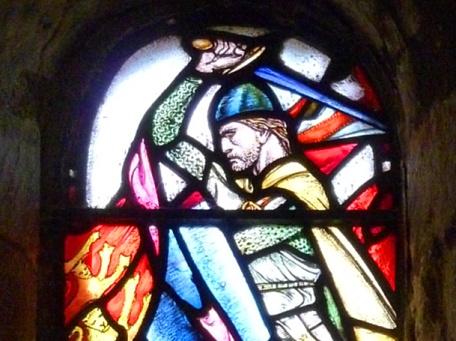
Much has been made of the historical inaccuracies in Randall Wallace's screenplay for the award-winning film "Braveheart." There are, in fact, only a handful of reliable events recorded about William Wallace: the battles at Stirling Bridge and Falkirk, his execution, and a letter dated October 11, 1297, not discovered until 1829, in which he wrote to the Hanseatic League after the victory at Stirling Bridge, proclaiming Scotland free of English tyranny and inviting the European merchant guilds to reciprocate in trade with Scottish merchants.
So, what was the source and inspiration for Wallace's murdered wife Murron, precognitive dreams, mass execution by hanging, and blue warpaint featured in Hollywood's vision of William Wallace? The answer lies in Blind Harry's Wallace, a twelve-book, 11,877 stanza poem.
Information on Blind Harry, also known as Henry the Minstrel, is scarce but it is believed that he lived c.1440-1493 and was blind from birth. There are records of payments to Blind Harry for performances at court from the years 1473-1492. The only surviving manuscript of Blind Harry's Wallace (National Library of Scotland MS Advocates 19.2.2), was copied in 1488 by John Ramsay, who has been identified as a cleric and notary of St. Andrews' diocese.
The epic poem, written more than 150 years after Wallace's death, is purported to be based upon the writings of John Blair, a childhood friend of Wallace's who became a Benedictine monk. According to Harry, Blair left the monastery at Dunfermline to become Wallace's personal chaplain and confessor, and subsequently wrote The Life of Sir William Wallace in 1327 at the request of Bishop William Sinclair of Dunkeld. Historians deny Harry's claim that Blair's book was commissioned by Bishop Sinclair (d. 1337), citing lack of proof. However, the Bishop was one of the protagonists of the War of Independence, so the possibility of him commissioning a biography of Wallace to demonstrate the virtue of the Scottish cause is plausible.
Evidence of the existence of a Wallace biography written by Blair is sketchy at best. An edition of Blind Harry's Wallace, printed in Edinburgh in 1758 is followed by Relationes Quaedam Arnaldi Blair Monachi de Dumermelem, at Capellani D. Willielmi Wallace Militis (The Life of William Wallace by Arnold Blair, a Monk of the Benedictine Cloister of Dunfermline), in a mix of Latin and English, but there is no substantiation that this is truly the work of John Blair. The Annals of Dunfermline and Vicinity by Ebeneezer Henderson (1879) gives the same title for Blair's manuscript, stating that Blair was also known as Arnold, and includes the notation: Vide Cottonian MSS.
The Cottonian Manuscripts were collected by Sir Robert Cotton (d. 1631) and presented to The British Museum by his grandson, Sir John Cotton, in 1700. They were housed in 1729 in Ashburnham House, Westminster, where a fire broke out in 1731 destroying or damaging a quarter of the manuscripts. Was John Blair's manuscript about William Wallace destroyed in the fire? There is no documentation stating that it was destroyed; there is no documented proof that it was one of the Cottonian manuscripts housed in Ashburnham House. If it did exist, there are no copies remaining today.
There are many episodes in Harry's poem which will never be possible to prove as having occurred. However, there are passages that have been proven false. One example comes from the opening stanza, in which Harry states that Wallace was the son of Malcolm Wallace, yet the letter Wallace wrote to the Hanseatic League after the Scots' victory at the Battle of Stirling carried Wallace's seal, which clearly states that he was "Wilelmus Filius Alani Walais" – William, son of Alan Wallace. Harry's recounting of the Battle of Falkirk, July 1298, provides another example: it is documented that this battle was won by the English side, yet Harry's version maintains that the Scots had the advantage, and concludes with King Edward fleeing in fear for his life.
Regardless of whether Harry had sources beyond oral tradition upon which to base his poem, and the fact that the poem reads as a biography of William Wallace, it should be considered historical fiction – a long-lived ballad that expresses profound pride in a nation's patriot hero.
Sources:
The Kingdom of England and the Kingdom of Scotland fought dozens of battles with each other. They fought typically over land, particularly Berwick-Upon-Tweed, and the Anglo-Scottish border frequently changed as a result. Read more at Wikipedia.

The First War of Scottish Independence was the initial chapter of engagements in a series of warring periods between English and Scottish forces lasting from the invasion by England in 1296 ... Read more at Wikipedia.

Edward I (1239-1307), also known as Edward Longshanks and the Hammer of the Scots, was King of England from 1272 to 1307. Read more at Wikipedia.